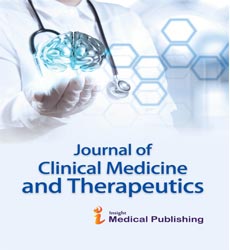Optimizing Antibiotic Stewardship in Clinical Practice
Rebecca Matteo*
Department of Medicine, National Defense Medical University, Neihu District, Taipei City 15890, Taiwan
*Corresponding author:
Rebecca Matteo,
Department of Medicine, National Defense Medical University, Neihu District, Taipei City 15890, Taiwan,
E-mail: Matteo.rebecc@gmail.com
Received date: February 01, 2025, Manuscript No. ipjcmt-25-20830; Editor assigned date: February 03, 2025, PreQC No. ipjcmt-25-20830 (PQ); Reviewed date: February 15, 2025, QC No. ipjcmt-25-20830; Revised date: February 22, 2025, Manuscript No. ipjcmt-25-20830 (R); Published date: February 28, 2025
Citation: Matteo R (2025) Optimizing Antibiotic Stewardship in Clinical Practice. J Clin Med Ther Vol.10 No.1:05
Introduction
Antibiotics have been pivotal in reducing morbidity and mortality associated with bacterial infections, revolutionizing modern medicine. However, the widespread and often inappropriate use of antibiotics has led to a global surge in AntiMicrobial Resistance (AMR), undermining the effectiveness of these life-saving drugs. Antimicrobial resistance not only increases treatment failures and complications but also results in prolonged hospital stays, higher healthcare costs and elevated mortality rates. Addressing this challenge necessitates a multifaceted approach centered on antibiotic stewardship, a coordinated effort to optimize antibiotic use to achieve the best clinical outcomes while minimizing resistance and adverse effects. Antibiotic stewardship encompasses strategies to ensure that patients receive the right antibiotic, at the right dose, for the right duration and through the right route of administration. Effective stewardship balances the need for timely, empiric therapy in acute infections with the imperative to limit unnecessary or suboptimal antibiotic exposure. Clinicians, pharmacists, microbiologists, infection control specialists and healthcare administrators all play critical roles in implementing stewardship programs. Beyond hospital settings, stewardship extends to outpatient care, long-term care facilities and community practice, highlighting the importance of a comprehensive approach to preserving antibiotic efficacy.
Description
Optimizing antibiotic stewardship in clinical practice involves a combination of core principles, targeted strategies and interdisciplinary collaboration. One fundamental principle is accurate and timely diagnosis. Empiric antibiotic therapy should be guided by clinical presentation, local resistance patterns and established guidelines, while definitive therapy should be tailored based on microbiological results. Rapid diagnostic tests, including Polymerase Chain Reaction (PCR), antigen detection assays and point-of-care molecular diagnostics, facilitate early identification of pathogens, enabling targeted therapy and minimizing broad-spectrum antibiotic use [1].
Another key strategy is adherence to evidence-based prescribing guidelines. Clinical decision support tools integrated into Electronic Health Records (EHRs) provide real-time guidance on appropriate antibiotic selection, dosing, duration and potential drug interactions. Standardized protocols, including formulary restrictions, pre-authorization requirements and automatic stop orders, ensure that antibiotics are used judiciously and consistently across healthcare settings. Educational initiatives targeting prescribers, nurses and pharmacists reinforce guideline adherence and promote awareness of AMR risks and stewardship principles [2].
Dose optimization and de-escalation are critical components of stewardship. Initiating therapy with the narrowest effective spectrum, adjusting doses based on pharmacokinetic and pharmacodynamic principles and switching from intravenous to oral formulations when appropriate reduce the risk of resistance and adverse effects. De-escalation involves narrowing or discontinuing antibiotics once culture results or clinical improvement indicate that broad-spectrum coverage is no longer necessary. This approach requires close monitoring of clinical progress, laboratory markers and microbiological data [1]. Monitoring and feedback are integral to successful stewardship programs. Audit and feedback systems evaluate prescribing patterns, adherence to guidelines and patient outcomes, providing prescribers with individualized performance reports. Peer comparison and benchmarking can further motivate adherence to stewardship principles. Additionally, stewardship teams track resistance trends, antibiotic utilization metrics and adverse events to inform policy adjustments and optimize antibiotic selection [2].
Conclusion
Optimizing antibiotic stewardship in clinical practice is essential to combat the escalating threat of antimicrobial resistance, improve patient outcomes and preserve the effectiveness of existing antibiotics. Stewardship integrates accurate diagnosis, evidence-based prescribing, dose optimization, de-escalation strategies and interdisciplinary collaboration to ensure judicious use of antimicrobial agents. Rapid diagnostics, clinical decision support systems, AI-driven analytics and pharmacist-led initiatives enhance the precision, efficiency and impact of stewardship programs across hospital, outpatient and community settings.
Infection prevention, patient education and adherence monitoring complement stewardship efforts, reducing the need for unnecessary antibiotic use and preventing the spread of resistant pathogens. Emerging therapeutic alternatives, including novel antibiotics, bacteriophage therapy and immunomodulatory agents, expand treatment options while supporting stewardship objectives. Global initiatives, national guidelines and collaborative networks further reinforce standardized practices and ensure the sustainability of stewardship interventions. While challenges such as limited resources, prescriber variability and behavioral barriers exist, the integration of evidence-based strategies, technological innovations and multidisciplinary approaches holds the potential to optimize antibiotic use effectively. By implementing robust antibiotic stewardship programs, healthcare providers can mitigate resistance, enhance treatment efficacy, reduce healthcare costs and safeguard public health for current and future generations. The continued evolution of stewardship, informed by clinical research, technological advancements and global collaboration, will remain pivotal in addressing the complex and urgent challenge of antimicrobial resistance.
Acknowledgement
None.
Conflict of Interest
None.
References
- Soriano A, Martínez JA, Mensa J, Marco F, Almela M, et al. (2000) Pathogenic significance of methicillin resistance for patients with Staphylococcus aureus bacteremia. Clin Infect Dis. 30: 368-373.
Google Scholar Cross Ref Indexed at
- Vincent JL, Opal SM, Marshall JC, Tracey KJ (2013) Sepsis definitions: time for change. Lancet 381: 774-775.
Open Access Journals
- Aquaculture & Veterinary Science
- Chemistry & Chemical Sciences
- Clinical Sciences
- Engineering
- General Science
- Genetics & Molecular Biology
- Health Care & Nursing
- Immunology & Microbiology
- Materials Science
- Mathematics & Physics
- Medical Sciences
- Neurology & Psychiatry
- Oncology & Cancer Science
- Pharmaceutical Sciences
